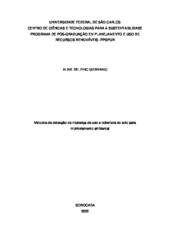Mostrar el registro sencillo del ítem
Métodos de detecção de mudança de uso e cobertura do solo para monitoramento ambiental
| dc.contributor.author | Germano, Aline Delfino | |
| dc.date.accessioned | 2022-08-09T18:06:07Z | |
| dc.date.available | 2022-08-09T18:06:07Z | |
| dc.date.issued | 2022-06-09 | |
| dc.identifier.citation | GERMANO, Aline Delfino. Métodos de detecção de mudança de uso e cobertura do solo para monitoramento ambiental. 2022. Tese (Doutorado em Planejamento e Uso de Recursos Renováveis) – Universidade Federal de São Carlos, Sorocaba, 2022. Disponível em: https://repositorio.ufscar.br/handle/ufscar/16476. | * |
| dc.identifier.uri | https://repositorio.ufscar.br/handle/ufscar/16476 | |
| dc.description.abstract | Forest monitoring is currently indispensable for environmental planning. Through it, it is possible to detect and spatialize changes in land use and cover, becoming a tool for decision-making. In this context, the general objective of the study was to evaluate change detection methods (DM), which support the identification of changes in land use and cover in agricultural landscapes. The study was carried out in the Sarapuí river basin (SP, Brazil), using images from Landsat 5 and 8 satellites, in four different years. Three DM methods were evaluated, being them by normalized vegetation index (DMNDVI), by direct image difference (DMDID) and by change vector analysis (AVM), with and without radiometric and atmospheric corrections. Subsequently, a supervised classification of objects was performed and the respective DM thresholds were obtained. It was verified, using the Z test, that the methods differ statistically, except when the methods with and without correction are compared. Therefore, to define the most appropriate method, the methods were qualified by false positives and false negatives, and the DMNDVI presented better results. With the delimited areas of change, the intersection with the current use and land cover and with the priority areas for forest conservation in the study area was carried out. It was found that in the last thirty years, 22% of the total area of the basin suffered, at some point, changes in its use and soil cover, and in about 6.14% of its total area there was an increase in vegetation and in 15.97% loss of this coverage. In general, it is concluded that the DMNDVI method presents better results, helping in the decision-making process to identify areas for the payment of environmental services, that is, indicating areas where there was a gain in vegetation | eng |
| dc.description.sponsorship | Coordenação de Aperfeiçoamento de Pessoal de Nível Superior (CAPES) | por |
| dc.language.iso | por | por |
| dc.publisher | Universidade Federal de São Carlos | por |
| dc.rights | Attribution-NonCommercial-NoDerivs 3.0 Brazil | * |
| dc.rights.uri | http://creativecommons.org/licenses/by-nc-nd/3.0/br/ | * |
| dc.subject | Mata atlântica | por |
| dc.subject | Perda de floresta nativa | por |
| dc.subject | análise temporal | por |
| dc.subject | sensoriamento remoto | por |
| dc.subject | Mata Atlantic | eng |
| dc.subject | loss of native forest | eng |
| dc.subject | temporal analysis | eng |
| dc.subject | remote sensing | eng |
| dc.title | Métodos de detecção de mudança de uso e cobertura do solo para monitoramento ambiental | por |
| dc.title.alternative | Methods of change detection land use and cover for environmental monitoring | eng |
| dc.type | Tese | por |
| dc.contributor.advisor1 | Valente, Roberta Averna | |
| dc.contributor.advisor1Lattes | http://lattes.cnpq.br/1582627535733911 | por |
| dc.description.resumo | O monitoramento florestal torna-se, atualmente, indispensável para o planejamento ambiental. Por meio dele pode-se detectar e espacializar mudanças do uso e cobertura do solo, tornando-se uma ferramenta para a tomada de decisão. Neste contexto, o objetivo geral do estudo foi avaliar métodos de detecção de mudanças (DM), que suportem a identificação de alterações do uso e cobertura do solo em paisagens agrícolas. O estudo foi realizado na bacia do rio Sarapuí (SP, Brasil), utilizando imagens dos satélites Landsat 5 e 8, em quatro diferentes anos. Avaliou-se três métodos de DM, sendo eles por índice de vegetação normalizada (DMNDVI), por diferença de imagem direta (DMDID) e por análise de vetor de mudança (AVM), com e sem correções radiométrica e atmosférica. Posteriormente, realizou-se uma classificação supervisionada a objetos e obteve-se os respectivos limiares de DM. Verificou-se, usando o teste Z, que os métodos se diferenciam estatisticamente, exceto quando comparados os métodos com e sem correção. Portanto, para definir o método mais adequado, qualificou-se os métodos pelos falsos positivos e falsos negativos, e o DMNDVI apresentou melhores resultados. Com as áreas de mudanças delimitadas realizou-se a intersecção com o uso e cobertura do solo atual e com as áreas prioritárias para conservação florestal da área de estudo. Obteve-se, que nos últimos trinta anos, 22% da área total da bacia sofreu, em algum momento, mudanças em seu uso e cobertura do solo, sendo que em cerca de 6,14% de sua área total houve incremento de vegetação e em 15,97% perda desta cobertura. De forma geral, conclui-se que o método DMNDVI apresenta melhores resultados, auxiliando na tomada de decisão para identificação das áreas para o pagamento dos serviços ambientais, ou seja, indicando áreas em que houve ganho de vegetação | por |
| dc.publisher.initials | UFSCar | por |
| dc.publisher.program | Programa de Pós-Graduação em Planejamento e Uso de Recursos Renováveis - PPGPUR-So | por |
| dc.subject.cnpq | OUTROS | por |
| dc.publisher.address | Câmpus Sorocaba | por |
| dc.contributor.authorlattes | http://lattes.cnpq.br/5739783500252918 | por |


